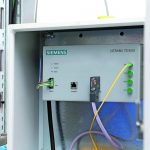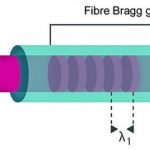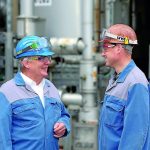In-line measurements of temperature profiles in applications where space is restricted represent a daunting challenge for the measuring equipment. This is particularly true when it comes to determining the temperature profiles in tube or tube bundle reactors. A large number of temperature measuring points are needed in order to optimise and maintain the catalyst activity; these were difficult to achieve using conventional measurement technology owing to the small diameter of the reactor tubes, the required number of measuring points and the necessary measurement speed. The fibre-optic temperature measuring system developed by Siemens in response to this problem is based on the fibre Bragg principle. Fibre Bragg gratings are created by inscribing optical periodic structures into the core of an optical fibre. Since only a defined wavelength of the incident light is reflected while all others are transmitted, each grating acts like a filter with a narrow bandwidth.
Wavelengths determine temperature
Sitrans TO500 temperature transmitters use fibre Bragg gratings (FBGs), which are arranged at individually defined points on the sensor probe. The transmitter sends light waves to the fibre-optic sensors and evaluates the reflected portions. In the transmitter, light is generated in the wavelengths from 1500 to 1600 nm and output to the sensor probe by means of a continuously tunable laser. Each fibre Bragg grating reflects light of a defined wavelength, which varies depending on the temperature at the measuring point.
Since the measured value transfer (reflection of the light) takes place in the same fibre, no additional cables are necessary, so that a much smaller cross section of the protective tube is possible for this measurement set-up. This firstly means that more reaction space is available in the reactor, with a positive impact on the throughput. Secondly, the sensors have faster response times because the damping effect of the air gap between the fibre in which the gratings are inscribed and the tube walls can be reduced to a minimum.
Synchronous measurements
The system consists of a transmitter to which up to four fibre-optic probes with up to 48 FBGs each can be connected. 192 temperature measuring points can therefore be processed synchronously by a single measuring system. Siemens tailors the measuring probes – the length, number of sensors and sensor positioning – individually to each specific application.
Each probe with a diameter of less than 2 mm measures temperatures in the range from 0 to 400 °C with an accuracy of 0.5 K. The response time is equally impressive, namely less than 4 s for T90.
A gas cell with a fixed absorption line serves as a reference in the Sitrans TO500 and the wavelength determination is continuously adjusted by it. The transmitter provides the values which are determined in this way for analysis in control systems via a Profibus DP interface, so that they can be made available for management of the assets and optimisation of the process. The parameters of the Sitrans TO500 are set via the integrated Ethernet interface.
Pilot project in Marl
A pilot study with the Sitrans TO500 transmitter was conducted at a manufacturing plant for laurinlactam, a starting product for Vestamid L, belonging to Evonik Performance Materials GmbH of Marl. “Thanks to the fibre-optic measuring system, we can install a sufficient number of temperature measuring points in a single tube reactor to enable us to detect excessive local temperatures at an early stage and initiate suitable corrective action”, explains Matthias Hüning, who works in the electrical measurement and control systems section of Evonik Resource Efficiency GmbH’s High Performance Polymers Business Line in Marl. “Our operators are now aware of any hotspots which occur, or any change in the catalyst activity, in good time. In the former case, we use this information to take steps to reduce the temperature, for example. In the latter instance, we can carry out maintenance procedures such as replacing the catalyst at precisely the right moment in the ageing process. Both applications extend the lifetime of the catalyst in the reactor. Predictive maintenance on demand is now a reality.”
Catalyst loading reduced
Applications for non-contact measurement methods with fibre-glass sensors are increasingly widespread in the chemical industry. These sensors are insensitive to electromagnetic interference and resistant to the majority of chemicals. The ability to couple the optical signals is a further advantage. In the Evonik installation, Siemens uses a fibre-optic coupler to connect the measurement fibre in the reactor and the transmission line to the transmitter. This coupler can simply be disconnected for maintenance, for example in order to open the reactor cover. Prior to inspecting the reactor or replacing the catalyst, the measuring probe can be removed easily and rolled up on a spindle for safe and problem-free transport.
The speed and accuracy of the temperature profile measurements, for instance during gas-phase reactions in a fixed-bed reactor, helps determine the thermal load within the catalyst filling and initiate suitable countermeasures to keep it active. The optical measurement system implemented by Siemens provides an elegant way to simultaneously determine and process a large number of temperatures for monitoring and optimisation purposes. Disturbances can be detected efficiently and the reaction courses optimised, leading to a higher product throughput in the plant. Following an intensive trial phase, the application described here is now being introduced into production at Evonik.
Online search: cpp0317siemens












